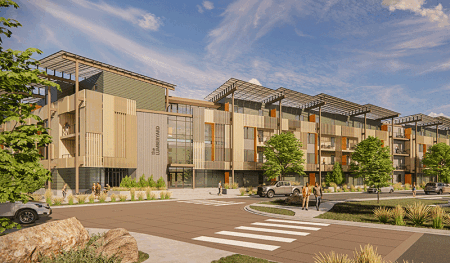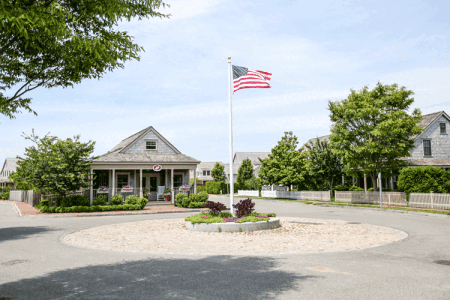
The city of Aspen, Colorado, plans to construct 277 deed-restricted housing units—195 for rent and 82 for sale—at Aspen Lumberyard, a former lumberyard close to the local airport and three miles (4.8 km) from the downtown core. A central plaza serves as a community gathering place for the 11.3-acre (4.6 ha) development. (Cushing Terrell)
Resort communities are appealing places to live year round, with stunning natural beauty and recreational opportunities in abundance. However, the same factors that make these places attractive can make them difficult for year-round and seasonal locals who run the ski lifts, fight fires, serve meals in restaurants, and teach in schools. Even as the COVID-19 pandemic raised awareness of the importance of essential workers, it has also exacerbated the housing affordability challenge with the rise of remote work and the resulting spike in second-home ownership rates.
Local governments are taking notice, devising innovative solutions to build more housing—and preserve existing housing stock—for their locals. With strategic planning and plenty of public outreach, five resort communities are taking on residents’ concerns over increased density and turning to new methods of ensuring that for-sale and rental housing stays within reach of the people who make these places function.
Rabun County, Georgia
Rabun County, Georgia, is home to three lakes as well as the Chattooga River, the Appalachian Trail, and the Tallulah Gorge. With a ski resort community and views of the Blue Ridge Mountains, it is a big draw for tourists and vacation homeowners, challenging workers and other locals to find a home of their own.
The public/private partnership Forward Rabun was formed three years ago to assist with economic and workforce development within the county and recently completed a strategic plan after extensive public input. “We didn’t want to tell the people of the county what they should do,” says Robert Pittman, vice chairman of Forward Rabun’s executive committee. “We wanted the people of the county to tell us what to do.”
An analysis of the county’s strengths identified its scenic beauty and its proximity to Atlanta, Nashville, Greenville, and Spartanburg. “But there are also some weaknesses that we have, being a rural area,” Pittman adds. “Also, Rabun County is 70 percent owned by either the U.S. Forest Service or Georgia Power. That doesn’t give us a whole lot of land to work with, and a lot of that land is mountainous—that’s one issue we have with building more housing.”
Because of the popularity of second homes, the average home price in Rabun County is much higher than that of most rural areas of Georgia, says Pittman. “However, incomes here are what you would find in most rural areas of Georgia, because the county is heavily reliant on tourism, and a lot of jobs in the tourist industry don’t pay a whole lot.” Local businesses are hard pressed to find employees as a result.
Because the bucolic nature of the region is a big part of its appeal, there has been resistance to building multifamily housing. “Many of our zoning laws call for minimum one-acre lots for residential houses,” Pittman says. In early February, a ULI technical assistance panel visited the county to help find a way out of the housing shortage. The panel suggested that the development authority of Rabun County use its statutory powers to structure innovative deals with housing developers, make denser housing in the county attractive by employing “new urban” village layouts, pursue grants to facilitate housing development and develop a database of suitable housing locations. Development would likely focus on the two largest cities, Clayton and Dillard, says Pittman.

Located on the island of Nantucket, Massachusetts, Beach Plum Village consists of 40 single-family cottages, 10 of which are permanently restricted at moderate prices to be affordable to year-round residents. Configured as one- and two-story houses with cedar shingle roofs and siding, Beach Plum Village’s dwellings are designed to fit the historic character of Nantucket’s architecture. (Josh Posner)
Beach Plum Village, Nantucket, Massachusetts
According to one recent estimate by Nantucket Data Platform, the average summer population in Nantucket has grown by nearly 70 percent since 2014 and is on track to rise to 100,000 by 2030.
“So many people are buying their second home in Nantucket with cash, and the pressure on the housing stock is still really intense,” says Josh Posner, founder and chief executive officer of Rising Tide Development in Cambridge, Massachusetts. “People who are earning a living and critical to the functioning of the year-round community—teachers, police, firefighters, store clerks, construction workers, town employees—are all under tremendous pressure. Hardly a week goes by without hearing about some much-loved member of the community who says, ‘I love Nantucket, but I can’t afford to live here.’”
Rising Tide Development made use of state statute Chapter 40B to create Beach Plum Village, a for-sale development with 30 market-rate houses and 10 permanently affordable houses for households earning 70 percent of area median income. Chapter 40B allows developers to bypass local zoning rules if at least 20 to 25 percent of the units have long-term affordability restrictions. Completed in 2020, Beach Plum Village’s market-rate and affordable houses are mixed in with each other and indistinguishable from the outside. “There’s no government subsidy,” Posner says. “It uses the ability to build at a higher density than would otherwise be allowed under zoning to build additional market-rate homes and use those profits to underwrite the net costs of the affordable homes.”
Posner says the success of Beach Plum Village shows that buyers of high-end housing are not put off by the idea of living in a community with affordable houses in the mix: “People are perfectly happy to pay hardly any discount at all for their market-rate home, even if it’s next door to an affordable home—assuming that the development is well designed and in a place that people are attracted to want to live in.”
Rising Tide Development is working on another Chapter 40B project on Nantucket, Surfside Crossing, with 156 condominium units, 39 affordable to residents earning 80 percent of AMI and 117 market-rate units priced targeting the $450,000 to $825,000 price range, rare in Nantucket, so as to be affordable to year-round residents. A small group of people is expressing concern that it will too dense and will have a harmful effect on traffic, Posner says. “The only reason that Beach Plum Village happened was that 40B made it possible. The same is true for this new one.”

The Town of Vail’s voluntary Vail InDEED deed restriction program allows the town to purchase a deed restriction on houses. The restriction requires the property to be occupied as a primary residence by individuals who work a minimum of 30 hours a week in Eagle County. (Jack Affleck, Courtesy of Vail Local Marketing District)
Vail InDEED, Vail, Colorado
The year-round population of Vail is 5,300, but of the town’s 7,200 dwelling units, about 70 percent are classified by the U.S. Census as being either vacant or unoccupied, says George Ruther, housing director for the Town of Vail. “That’s our second homeowner population,” he adds. “That’s been the affordability issue, with this last uptick in housing prices. The average home price in the town of Vail exceeds $2.3 million, and rental rates have increased by over 40 percent. With our topography and geography, we’re not going to be able to build our way out of this.”
One tool the town was using to make housing more affordable was to buy a residential property, place a deed restriction on it, and then resell it with the deed restriction limiting the occupancy to someone working and living locally. To speed up the process, the town decided to skip the process of purchasing the home. “We don’t have to buy the whole house,” Ruther says. “We just have to buy a deed restriction.” To meet the terms of the restriction, the property must be occupied as a primary residence by individuals who work a minimum of 30 hours a week in Eagle County.
The Vail InDEED program has been a game changer, Ruther says. “Through Vail InDEED, we’ve spent nearly $13 million on deed restriction purchases, which provide homes for more than 380 residents.” Although the program was not designed to be a down payment assistance program, “when you look at the price the town pays for a deed restriction, in many instances, it is somewhere between 15 and 20 percent of the fair market value of that home,” he adds. “With 15 or 20 percent, the Town of Vail becomes the rich aunt or rich uncle at the closing table, and they help a homebuyer make that down payment that they need to get into conventional financing.”
Area employers are also participating in the program as well, Ruther says. “For the first time in a long time, we have employers stepping up and providing housing for their employees the way people had always hoped.”
Vail’s program has no household size requirements, no income limitations on who can reside in the home, and no price appreciation cap on the resale of the home. “It’s simply a deed restriction that limits the occupancy of the home, and there’s a tie to employment,” Ruther says. “We didn’t need to have extraneous restrictions that only cause people to not want to participate.”
Aspen Lumberyard, Aspen, Colorado
Pitkin County and City of Aspen began constructing its own deed-restricted housing in the 1970s. In 1982, the city and county formed the Aspen/Pitkin County Housing Authority, an independent multi-jurisdictional housing authority that oversees affordable housing for permanent residents earning low, moderate, and middle incomes.
But the challenge of providing housing has only grown in this popular ski resort area. In 2019, the Greater Roaring Fork Regional Housing Study found that the Aspen to Snowmass region had a 4,000-unit shortfall for households earning less than 160 percent of area median income, a number anticipated to increase to 5,200 units by 2027.
The city’s largest affordable housing development is Aspen Lumberyard, a new neighborhood that will ultimately include 277 units, including 195 for rent and 82 deed-restricted for-sale units. “The pressure of this emergency has got folks’ attention and they are recognizing that they absolutely need to do projects of scale,” says Randy Rhoads, executive director of affordable housing for Cushing Terrell, which is designing the project.
The development’s name is a nod to the lumberyard three miles from downtown Aspen that the city purchased in 2008 and land-banked for future affordable housing. The city later acquired an an adjacent storage facility in 2019 and added other city-owned property, bringing the site up to 11 acres. The site lies next to Aspen Airport Business Center and near the local airport and is, which includes businesses and residences. The new development will be linked to the surrounding neighborhood and existing trails with pedestrian- and bike-friendly pathways. An extensive public process, both in-person and on live video, informed the new neighborhood’s design.
Infrastructure improvements are expected to begin in 2024, with the first building phase slated to begin in 2026. “The vast majority of the people that I interact with, whether they’re in city departments or owners of design firms that are consultants of ours, have told me the reason that they can afford to live in Aspen is because the city, since the 1980s, has been building affordable housing, both for rent and for sale,” Rhoads says. “In a community like Aspen, the city could not function if the city wasn’t helping create this affordable housing that’s set up for a mixture of incomes.”
Brown Ranch, Steamboat Springs, Colorado
Steamboat Springs is a winter ski resort town in the Rocky Mountains with roots in the ranching and mining industries. The town has a shortfall of 1,400 housing units, and the average sale price of homes shot up 70 percent since 2019.
Since 2003, the Yampa Valley Housing Authority (YVHA) has been creating and operating housing programs for low- and moderate-income residents employed in Routt County. In 2017, the authority pledged to create 600 new affordable and attainable dwellings in the Steamboat Springs area by 2030. However, finding land to build on proved difficult.
Brown Ranch, a 534-acre property adjacent to the city limits and within the urban growth boundary, seemed to be the ideal solution. However, the authority lacked the funds to buy the parcel until an anonymous donor allowed the authority to acquire the land in 2021. The authority conducted an extensive bilingual and multigenerational outreach effort before producing a community development plan under the guidance of a steering committee of 20 locals.
“Housing in places like Steamboat Springs has a critical relationship to the economic health of the community,” Patrick Phillips, former Global CEO of the Urban Land Institute and a member of the steering committee. “It’s become clear to the community that a broad swath of the workforce is ill-housed. They cannot afford to live here or commute long distances.”
The YVHA invited ULI’s Advisory Services team to assess the plan. The panel recommended that YVHA serve as steward for its vision; find a private-sector fee-development partner with community-scale experience to oversee the technical development process and project delivery; widen the definition of affordability to include elderly, disabled, and wage earners at lower-income levels; and help build capacity within the YVHA, the city, social service providers, and local businesses.
The authority issued a request for qualifications/proposals from private developers in February 2023. The plan calls for 1,124 units to be completed in the first phase, with the second and third phases comprising additional 1,140 units.
“The takeaway is that there’s no reason that a small community can’t do a world-class project,” Phillips says. “The long term cost of not addressing the affordability challenge head on is high. It’s not just about the costs of that kind of commute, both psychically and economically, or about the environmental impact of traffic congestion, but also about the soul of the community. It’s a city and a region that reflects a long mining, agriculture, and ranching heritage. It needs to have a balanced workforce, and it needs to have income diversity, to be true to itself.”

